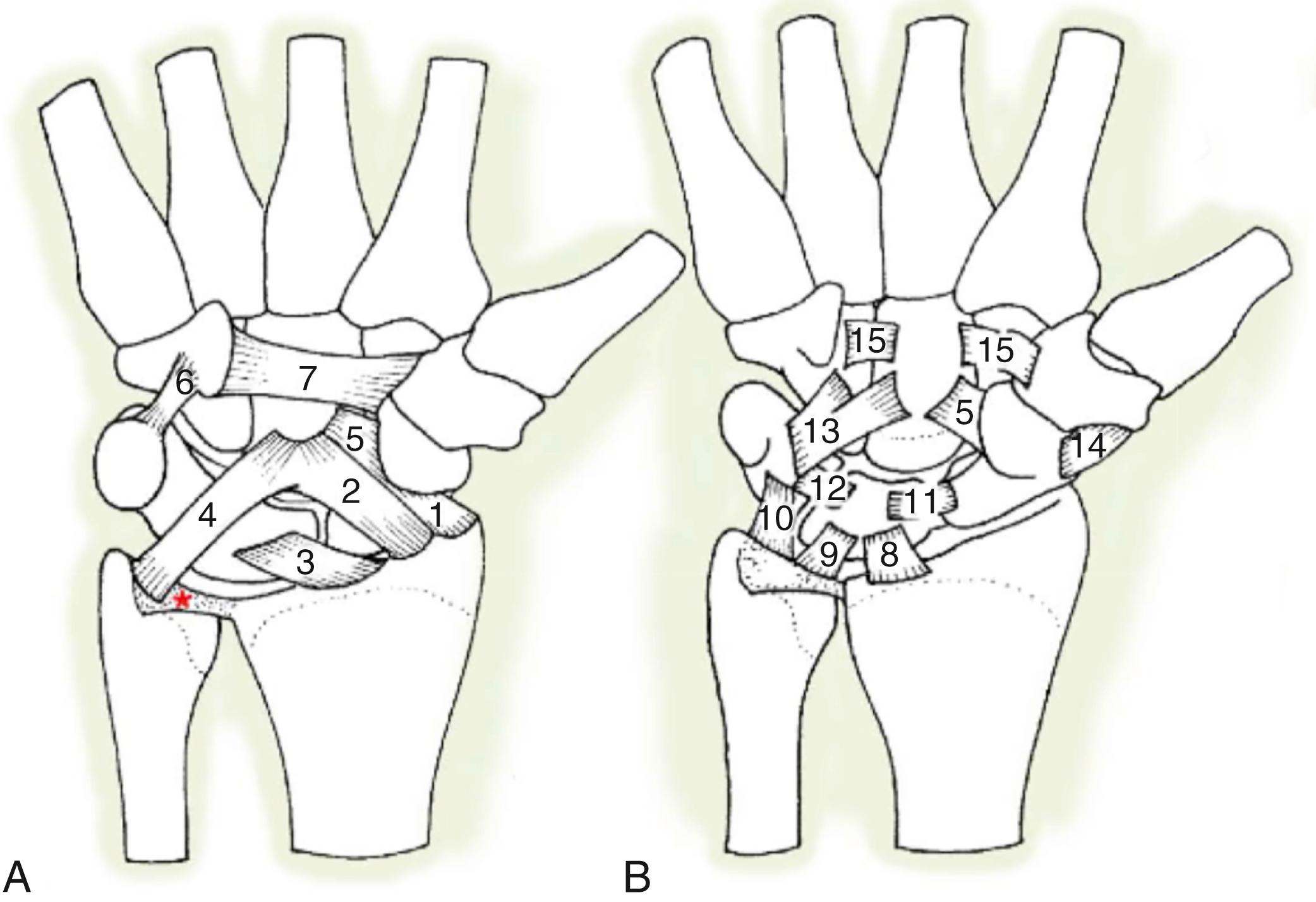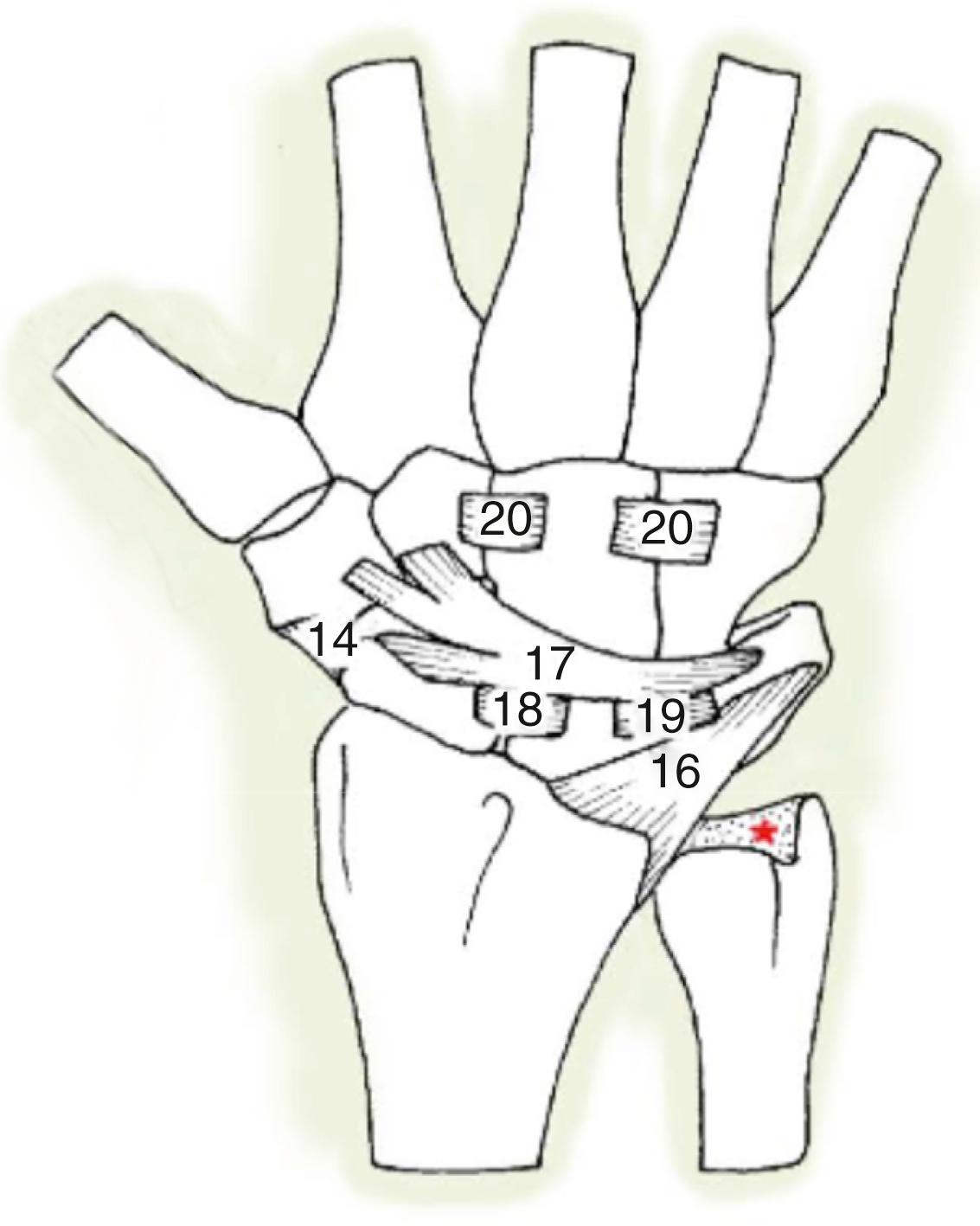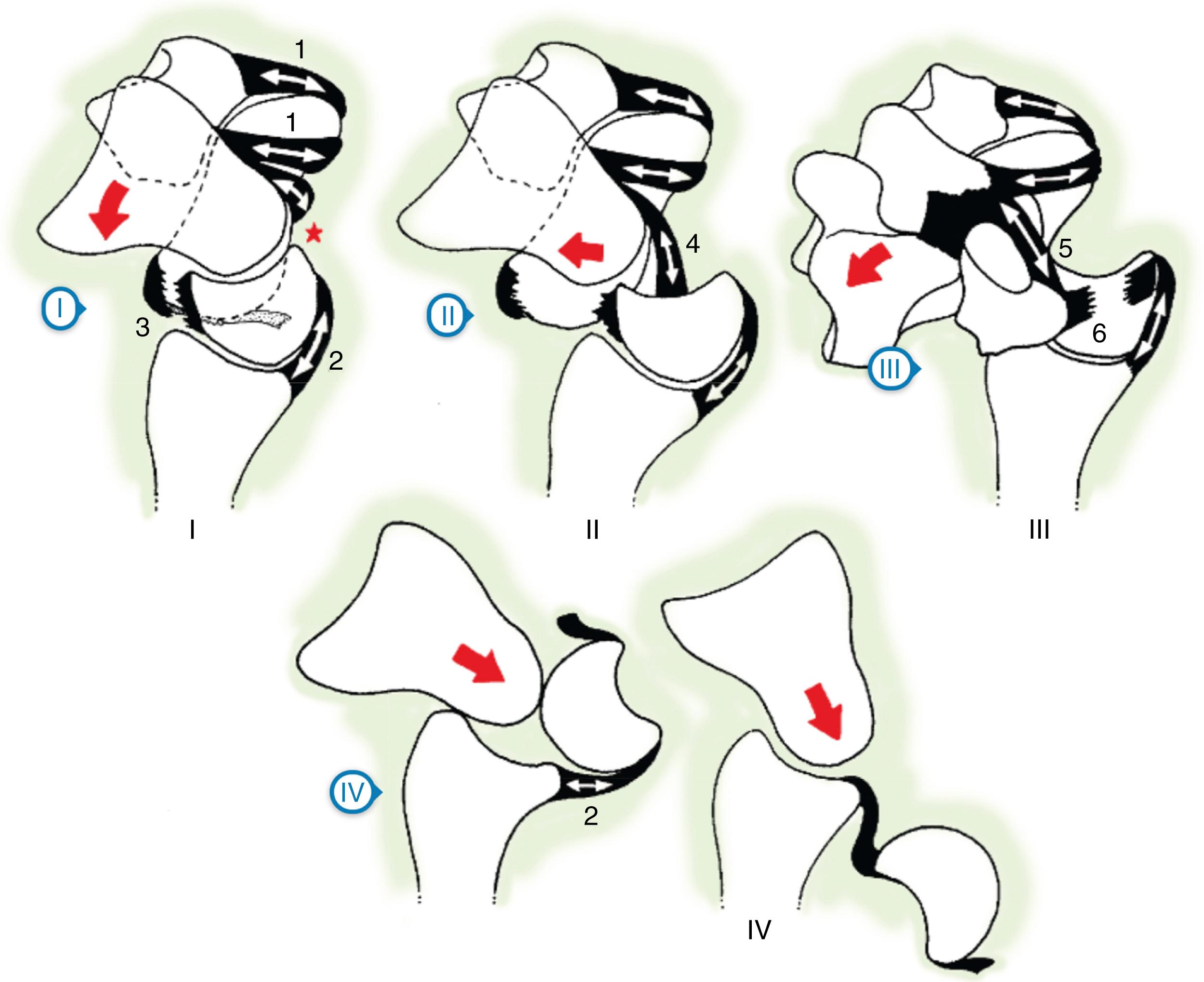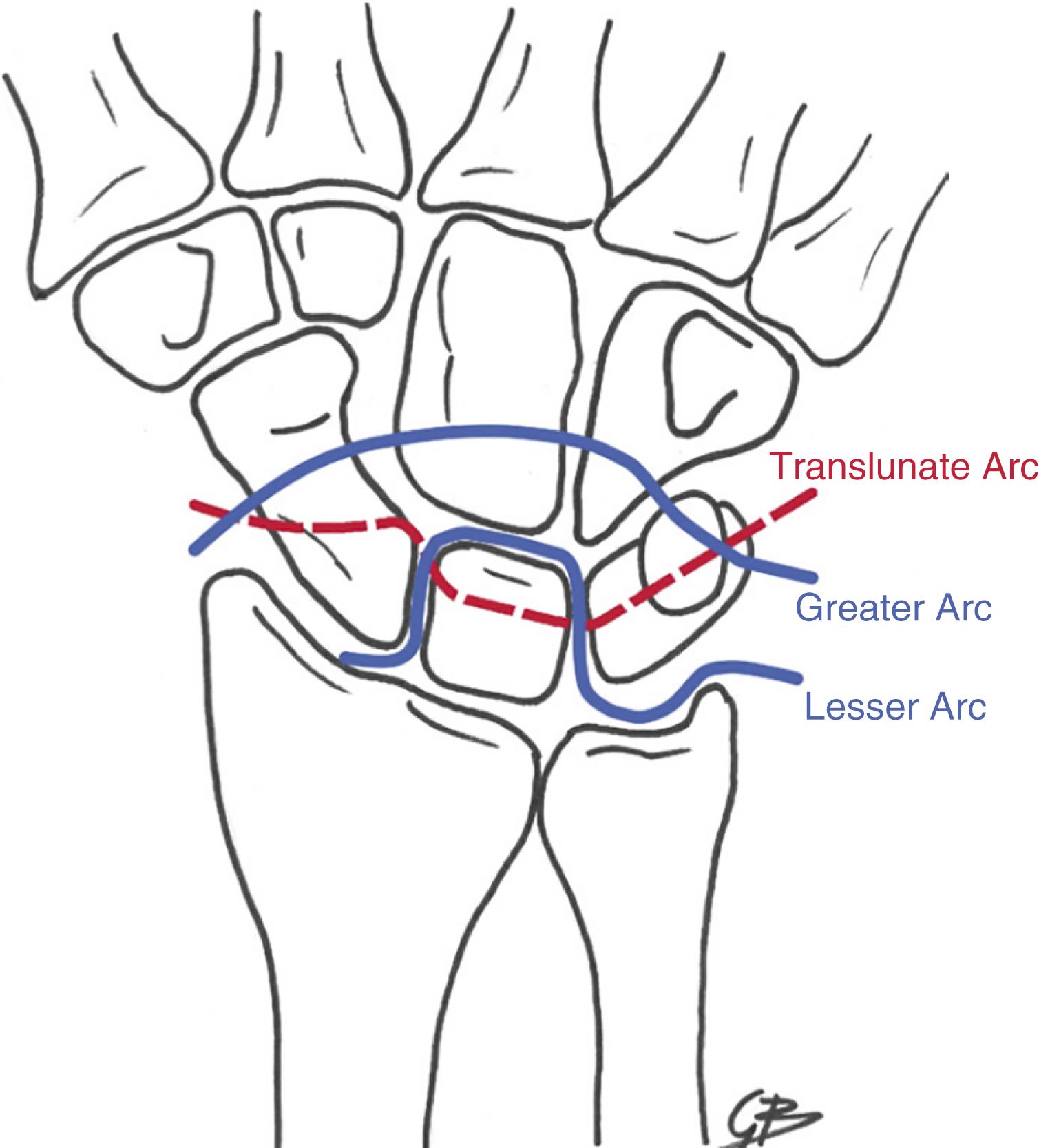Physical Address
304 North Cardinal St.
Dorchester Center, MA 02124
Perilunate injuries represent a challenge to the hand and wrist surgeon. Complex anatomy and kinematics, coupled with missed diagnoses and oft-delayed presentation, make the achievement of excellent outcomes difficult. It is our goal to present the essential information—anatomy, pathoanatomy, treatment options, surgical approaches, and expected outcomes—necessary for the hand and wrist surgeon to successfully identify and treat perilunate injuries.
Knowledge of the ligamentous and bony anatomy of the carpus is essential to properly diagnose and treat perilunate injuries. The function of the wrist is as a link between the forearm and the hand. The distal radius and distal ulna articulate with the proximal carpal row, which further articulates with the distal carpal row, which then articulates with the metacarpal bones. The distal articular surface of the radius, which consists of the scaphoid and lunate fossae, and the triangular fibrocartilage complex (TFCC) overlying the distal ulna, articulates with the proximal carpal row. The midcarpal joint can be separated into three distinct zones: radial, central, and ulnar. Radially, the scaphoid articulates with the trapezium and trapezoid, as well as with the radial capitate. Centrally, the lunate articulates with the capitate (in Type I lunates), or with both the capitate and the proximal pole of the hamate (in Type II lunates). Ulnarly, the midcarpal joint consists of the hamate-triquetral articulation.
All ligaments of the wrist are intracapsular apart from the transverse carpal ligament and the pisohamate/pisometacarpal ligaments. The remainder of the ligamentous anatomy of the wrist is separated into the extrinsic and intrinsic ligaments of the wrist. The extrinsic ligaments consist of the palmar radiocarpal ligaments, the palmar ulnocarpal ligaments, and the dorsal radiocarpal ligaments. The palmar radiocarpal ligaments consist of the radioscaphoid ligament, the radioscaphocapitate ligament, the long radiolunate ligament, and the short radiolunate ligament. The space of Poirier represents a relative weak zone of the volar capsule through which the lunate may dislocate. The palmar ulnocarpal ligaments consist of the ulnocapitate ligament, the ulnotriquetral ligament, and the ulnolunate ligament. The ulnocapitate ligament and the radioscaphocapitate ligament converge distally to form the arcuate ligament. The ulnotriquetral and ulnolunate ligaments arise from the TFCC. The dorsal radiocarpal ligament arises from the dorsum of the radius and travels to the triquetrum ( Fig. 72.1 ). ,

The intrinsic ligaments of the wrist originate and insert within the carpus. The scapholunate ligament consists of a dorsal segment, which plays a key role in scapholunate stability; a palmar segment, which plays a lesser role; and a proximal membranous portion, which contributes minimally to stability. The lunotriquetral ligaments consist of a palmar segment, which is stronger and more significant for lunotriquetral stability; a dorsal component, which is less significant; and a proximal membranous portion, which is weakest. The dorsal intercarpal ligament that extends from the triquetrum across the lunate to the scaphoid, trapezium, and trapezoid functions to stabilize the lunocapitate joint, as no intrinsic ligaments link the lunate to the capitate. The palmar midcarpal intrinsic ligaments extend from the triquetrum to the hamate and capitate, and function as the ulnar arm of the arcuate ligament. Other midcarpal intrinsic ligaments include the scaphocapitate and dorsal scaphotrapezio-trapezoid (STT) ligaments. Distally, strong interosseous ligaments connect the distal carpal row to the metacarpals ( Fig. 72.2 ).

The pathomechanics of perilunate injuries follow progressive, predictable stages of carpal destabilization. The injury pattern is that of a forced hyperextension injury, in either ulnar or radial deviation, and is typically high energy, such as a motor vehicle collision or fall from a height. The energy that is transmitted through the carpus follows a pattern that, at each stage, may pass through and disrupt either ligamentous or bony anatomy. These two pathways are termed lesser arc injuries , for a ligamentous pathway of disruption, or greater arc injuries , for pathways that contain any element of bony disruption or fracture. While trans-scaphoid greater arc injuries usually result in preserved scapholunate ligament continuity with the proximal pole of the scaphoid, perilunate injury with concomitant scaphoid fracture and scapholunate ligament disruption has been described ( Fig. 72.3 ).
First Stage: As the wrist is forced into hyperextension, the distal carpal row pulls the scaphoid into extension through the STT and scaphocapitate ligaments. The lunate, however, is constrained extrinsically by the long and short radiolunate ligaments and is unable to follow the scaphoid into extension, leading to scapholunate ligament tearing and failure. If the wrist is hyperextended in radial deviation, however, the proximal pole of the scaphoid will be constrained by the radioscaphocapitate ligament, leading instead to scaphoid fracture as the transmission of energy. Scaphoid fracture occurs in approximately 60% of cases.
Second Stage: As the distal row and scaphoid continue to extend, now unconstrained following scaphoid fracture or scapholunate dissociation, they dislocate dorsally relative to the lunate, resulting in lunocapitate dissociation. Occasionally, the capitate may instead fracture, as the distal pole of the capitate migrates with the rest of the distal row and scaphoid, while the proximal pole of the capitate remains with the lunate. This dorsal translation may also result in tearing of the radioscaphocapitate ligament off the radial styloid with or without a fracture.
Third Stage: Dorsal translation of the capitate pulls the triquetrum dorsally through the arcuate ligament (triquetrum-hamate-capitate ligamentous complex). This tension results in tearing of the lunotriquetral ligaments, fracture of the triquetrum, or, rarely, fracture of the hamate. ,
Fourth Stage : The lunate remains constrained now only by dorsal capsule and radiolunate ligaments. As the capitate is pulled back into the radiocarpal space, it exerts a palmarly directed force onto the lunate. This results in lunate dislocation through the space of Poirier, often rotating into the carpal tunnel ( Fig. 72.4 ).


Mayfield’s cadaver studies were highly instructive in demonstrating the progressive ligamentous or osseous disruption of perilunate injuries. Mayfield’s classification system follows this progression in a staged fashion.
Stage I: Scapholunate instability
Stage II: Capitolunate dissociation
Stage III: Triquetrolunate dissociation
Stage IV: Lunate dislocation
The addition of a fifth stage has been suggested for dislocation with complete enucleation of the lunate with disruption of the short radiolunate ligament, significant for the loss of lunate vascularity and higher likelihood of avascular necrosis.
Become a Clinical Tree membership for Full access and enjoy Unlimited articles
If you are a member. Log in here